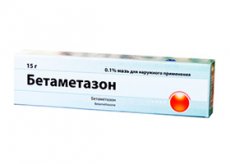Medical expert of the article
New publications
Preparations
Betamatease
Last reviewed: 23.04.2024

All iLive content is medically reviewed or fact checked to ensure as much factual accuracy as possible.
We have strict sourcing guidelines and only link to reputable media sites, academic research institutions and, whenever possible, medically peer reviewed studies. Note that the numbers in parentheses ([1], [2], etc.) are clickable links to these studies.
If you feel that any of our content is inaccurate, out-of-date, or otherwise questionable, please select it and press Ctrl + Enter.

Betamethasone has anti-inflammatory, anti-allergic and antipruritic properties.
Indications Betamethazone
It is used to relieve inflammation in dermatitis (this includes photodermatitis) and eczema, as well as nodular pruritis, red flat lishy, DKV, neurodermatitis and erythroderma, and in addition to thyroid dermopathy and Oppenheim-Urbach disease.
Also prescribed for the treatment of psoriasis on the skin under the scalp on the head and other types of psoriasis, excluding the extensive form of plaque psoriasis.
Pharmacodynamics
Betamethasone is a preparation of GCS, it blocks the process of migration of leukocytes, the appearance of lysosome enzymes in the intercellular space, as well as anti-inflammatory mediators in the area of inflammation. In addition, it inhibits phagocytosis, strengthens vascular strength and prevents the appearance of swelling in the area of inflammation.
Pharmacokinetics
After local treatment of the affected area with cream in therapeutic dosages, the absorption of the drug into the blood through the epidermis is very weak - 12-14%. Synthesis with blood protein is 64%. Participates in the processes of hepatic transformation.
Excretion of the drug occurs through the kidneys (most in the form of decay products), and only a small part is excreted with bile.
Absorption of betamethasone is enhanced by inflammation or damage to the epidermis, as well as by the use of hermetically sealed dressings.
Dosing and administration
The cream should be applied topically. The dosage regimen is selected separately for each patient.
A thin layer of cream is applied to the affected area of the epidermis twice a day, gently rubbing it. When there are symptoms of improvement, the frequency of use of drugs can be reduced to the 1 st time / day. The duration of therapy is determined by the rate of disappearance of inflammation, itching and purification of the epidermis. In addition, duration depends on the type of pathology and the degree of its severity. Often the treatment cycle lasts 1-2 weeks. The repeated course can be conducted after a minimum of 3 weeks from the end of the previous one.
Children or people with a lesion of the epidermis on the face can use the medicine for a maximum of 5 days.
Use Betamethazone during pregnancy
Use Betamethasone in lactation or pregnancy is allowed only if there are life indications and taking into account possible complications.
Contraindications
The main contraindications:
- skin lesions having a fungal, bacterial or viral nature;
- cutaneous tuberculosis;
- epidermal manifestations of syphilis;
- symptoms on the skin that result from vaccination;
- perioral form dermatitis;
- acne;
- plaque psoriasis;
- itching in the perianal region or in the genital area;
- varicosity;
- rosacea;
- the presence of hypersensitivity to the active element or other components of the drug.
Side effects Betamethazone
The use of medication can lead to such negative manifestations:
- skin lesions: prolonged use in one area can cause a burning sensation, irritation or dryness, and itching. More rarely there is acne, hyper- or hypopigmentation, folliculitis, dermatitis (contact or perioral form), hypertrichosis, skin maceration or atrophy, secondary infection, telangiectasia, skin stretch marks and sweating;
- general disorders: cushingoid, oppression of adrenal activity and a decrease in tolerance for carbohydrates. The child's depression of the adrenal function develops in the form of growth retardation, weight loss, increased ICP, fibrillation of the fontanelle, lowering blood levels of cortisol, ocular nerve puffiness and headache.
 [16]
[16]
Overdose
Long-term use of the cream on large areas of the epidermis causes the emergence of common negative symptoms characteristic of GCS: oppression of the function of the system of GGN, complicated by the development of adrenal insufficiency of a secondary nature, as well as cushingoid.
Symptomatic procedures are performed for therapy. Also, the electrolyte balance can be corrected.
Shelf life
Application for children
It is forbidden to appoint children under 2 years of age (excluding cases of life testimony).
Children who used local corticosteroids experienced growth retardation, suppression of adrenal function, an increase in ICP, as well as poor weight gain and development of Cushing's.
Analogues
The analogues of the medication are preparations Betliben, Acriderm, Beloderm Express with Betazon and Soderm, and in addition to this, Betamethasone valerate and Betamethasone dipropionate, as well as Celestoderm-B.
Reviews
Betamethasone receives good reviews - the ointment is excellent in coping with neurodermatitis, as well as with allergic symptoms on the epidermis. With strict adherence to prescribed medical instructions and compliance with the dosage regimen, the development of negative symptoms is noted only sporadically.
Attention!
To simplify the perception of information, this instruction for use of the drug "Betamatease" translated and presented in a special form on the basis of the official instructions for medical use of the drug. Before use read the annotation that came directly to medicines.
Description provided for informational purposes and is not a guide to self-healing. The need for this drug, the purpose of the treatment regimen, methods and dose of the drug is determined solely by the attending physician. Self-medication is dangerous for your health.

